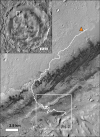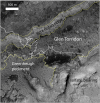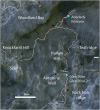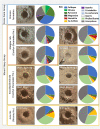The Curiosity Rover's Exploration of Glen Torridon, Gale Crater, Mars: An Overview of the Campaign and Scientific Results
- PMID: 37034460
- PMCID: PMC10078523
- DOI: 10.1029/2022JE007185
The Curiosity Rover's Exploration of Glen Torridon, Gale Crater, Mars: An Overview of the Campaign and Scientific Results
Abstract
The Mars Science Laboratory rover, Curiosity, explored the clay mineral-bearing Glen Torridon region for 1 Martian year between January 2019 and January 2021, including a short campaign onto the Greenheugh pediment. The Glen Torridon campaign sought to characterize the geology of the area, seek evidence of habitable environments, and document the onset of a potentially global climatic transition during the Hesperian era. Curiosity roved 5 km in total throughout Glen Torridon, from the Vera Rubin ridge to the northern margin of the Greenheugh pediment. Curiosity acquired samples from 11 drill holes during this campaign and conducted the first Martian thermochemolytic-based organics detection experiment with the Sample Analysis at Mars instrument suite. The lowest elevations within Glen Torridon represent a continuation of lacustrine Murray formation deposits, but overlying widespread cross bedded sandstones indicate an interval of more energetic fluvial environments and prompted the definition of a new stratigraphic formation in the Mount Sharp group called the Carolyn Shoemaker formation. Glen Torridon hosts abundant phyllosilicates yet remains compositionally and mineralogically comparable to the rest of the Mount Sharp group. Glen Torridon samples have a great diversity and abundance of sulfur-bearing organic molecules, which are consistent with the presence of ancient refractory organic matter. The Glen Torridon region experienced heterogeneous diagenesis, with the most striking alteration occurring just below the Siccar Point unconformity at the Greenheugh pediment. Results from the pediment campaign show that the capping sandstone formed within the Stimson Hesperian aeolian sand sea that experienced seasonal variations in wind direction.
© 2022 The Authors. California Institute of Technology. Government sponsorship acknowledged. This article has been contributed to by U.S. Government employees and their work is in the public domain in the USA.
Figures
























References
-
- Achilles, C. N. , Rampe, E. B. , Downs, R. T. , Bristow, T. F. , Ming, D. W. , Morris, R. V. , et al. (2020). Evidence for multiple diagenetic episodes in ancient fluvial‐lacustrine sedimentary rocks in Gale Crater, Mars. Journal of Geophysical Research: Planets, 125(8), e2019JE006295. 10.1029/2019JE006295 - DOI - PMC - PubMed
-
- Anderson, R. , & Bell, J. F. (2010). Geologic mapping and characterization of Gale Crater and implications for its potential as a Mars Science Laboratory landing site. The Mars Journal, 5, 76–128. 10.1555/mars.2010.0004 - DOI
-
- Banham, S. G. , Gupta, S. , Rubin, D. M. , Edgett, K. S. , Barnes, R. , Van Beek, J. , et al. (2021). A rock record of complex aeolian bedforms in a Hesperian Desert landscape: The Stimson formation as exposed in the Murray buttes, Gale Crater, Mars. Journal of Geophysical Research: Planets, 126(4), e2020JE006554. 10.1029/2020JE006554 - DOI
-
- Banham, S. G. , Gupta, S. , Rubin, D. M. , Bedford, C. C. , Edgar, L. , Bryk, A. B. , et al. (2022). Evidence for seasonal‐ to millennial‐scale wind fluctuations in an ancient aeolian dune field: Reconstruction of the Hesperian Stimson formation at Glen Torridon, Gale crater, Mars. Journal of Geophysical Research: Planets, 127, e2021JE007023. 10.1029/2021JE007023 - DOI
-
- Banham, S. G. , Gupta, S. , Rubin, D. M. , Watkins, J. A. , Sumner, D. Y. , Edgett, K. S. , et al. (2018). Ancient Martian aeolian processes and palaeomorphology reconstructed from the Stimson formation on the lower slope of Aeolis Mons, Gale crater, Mars. Sedimentology, 65(4), 993–1042. 10.1111/sed.12469 - DOI
LinkOut - more resources
Full Text Sources
Miscellaneous
